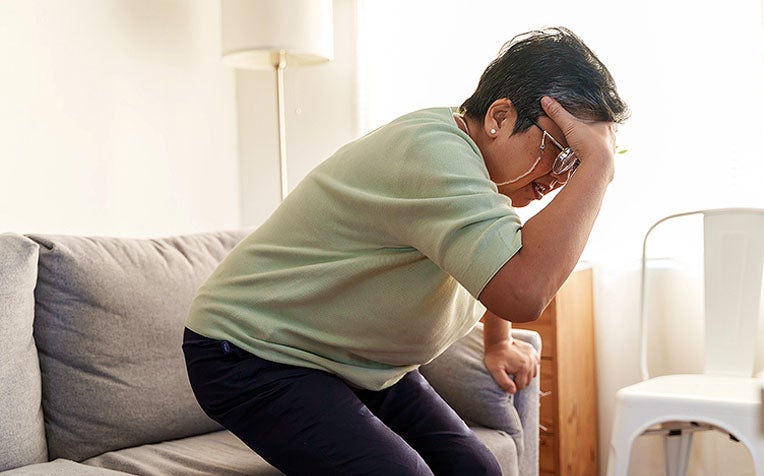
Low blood pressure (hypotension) can cause sudden dizziness when standing up too quickly (also known as postural hypotension). Fortunately, postural hypotension usually resolves on its own after a few seconds.
Low blood pressure: How does it occur?
Low blood pressure (hypotension) is a state where not enough blood (carrying oxygen) flows to vital organs such as the brain. It is mainly for this reason that one may experience dizziness.
It is known as “shock” when the drop in blood pressure is severe and persistent. If it is not treated immediately, shock can cause permanent damage to the vital organs, and may result in death.
Normal blood pressure is below 130/80 mmHg. The first reading measures systolic pressure or the amount of blood pressure when the heart is beating (squeezing the blood). The second reading measures diastolic pressure or the amount of blood pressure when the heart is at rest.
Some doctors consider blood pressure to be low when it is below 90/60 mmHg.
However, there is no specific number at which day-to-day blood pressure is considered too low as long as it does not cause noticeable signs and symptoms.
People who are physically fit sometimes have lower blood pressure. And some people have naturally low blood pressure, with no ill effects.
Low blood pressure: When to see a doctor
Low blood pressure (hypotension) with these signs and symptoms requires medical attention:
Dizziness
Fainting
Poor concentration
Blurred vision
Nausea
Hands feeling cold and clammy
Sudden pale skin
Rapid and shallow breathing
Tiredness
"These low blood pressure symptoms occur when there are inadequate blood flows to your vital organs," says Dr Ian Phoon, Consultant from SingHealth Polyclinics (SHP) – Pasir Ris, a member of the SingHealth group.
Postural hypotension vs vaso-vagal attacks
What is postural hypotension?
A person with low blood pressure (postural hypotension) may sometimes experience dizzy spells when standing up too quickly.
However, that usually disappears after a few seconds, as soon as your body has adjusted to the changes in position and blood pressure, and when normal blood flow has been restored to your brain.
Postural hypotension is an abnormal fall in blood pressure within three minutes of standing upright from lying or sitting. This happens due to the pooling of blood in the legs as a result of gravity. For the elderly, such dizziness may potentially result in falls, and if serious, may lead to hospitalisation or even death. Getting up slowly may help to reduce the sudden drop in blood pressure.
What are "vaso-vagal" attacks?
In addition, person with low blood pressure may feel faint when faced with certain triggers such as the sight of blood, the feeling of pain and emotions. This is known as a “vaso-vagal” attack, another type of transient low blood pressure.
For such people, the triggers will lead to an unusual slowing of the heart and dilatation of the blood vessels, and result in a drop in blood pressure; thus making one feels faint (known as “syncopy”).
“Postural hypotension and vaso-vagal attacks are very common, and most do not need any treatment as they are usually temporary. If dizziness is felt, sitting or stooping down often helps. Sometimes, such low blood pressure is caused by a sudden loss of blood volume, such as dehydration from severe diarrhoea, or any high blood pressure (hypertension) medication, especially if one has just started on the medication. Older people are more prone to this,” Dr Phoon said.
“However, if you are not taking any high blood pressure medication and yet experience persistent dizzy or fainting spells, there may be other underlying medical problems which require further investigations,” he added.
Serious causes of low blood pressure
Low blood pressure may be caused by many underlying medical conditions. The following conditions can be serious and may lead to shock.
Heart disease
Blood pressure may fall if the heart is not effective in pumping blood. Some of these heart conditions can be life-threatening. These conditions include abnormal heart rhythm (arrhythmia), heart attack (myocardial infarction), heart valve defects and heart failure.Decrease in blood volume
The decrease of blood volume in the body can be the result of the loss of body fluids or blood. Severe blood loss caused by external injuries such as an accident, or internal bleeding such as bleeding from stomach ulcers or very heavy menses, can cause low blood pressure. Loss of body fluids from conditions associated with severe vomiting and diarrhoea is another common reason for low blood pressure.Severe infection
When bacteria leave the original infection site (most often in the lungs, abdomen or urinary tract) and enter the bloodstream, it results in a severe infection known as sepsis. The bacteria release toxins that cause dilation of blood vessels, leading to a profound and rapid decline in blood pressure.Hormonal problems
Our body’s endocrine system consists of hormone-producing glands, e.g. thyroid gland, adrenal gland, pancreas, etc. An underactive thyroid (hypothyroidism) may cause low blood pressure. A low cortisol (“stress hormone”) level which is produced by the adrenal glands can cause low blood pressure as well. However, this is not a common cause of low blood pressure.Severe allergic reaction
There are various types of allergic reaction. These allergic reactions can occur in some people as a result of allergies to drugs (e.g. antibiotics), food such as peanuts or insect stings (e.g. bees or wasps). The most serious reaction is known as anaphylaxis, which can cause a sudden fall in blood pressure and can be fatal.
“The good news is that most low blood pressure cases do not need any treatment if there are
no symptoms. Serious low blood pressure cases are uncommon. However, if your symptoms persist, you are advised to see a doctor,” concludes Dr Phoon.
Ref: I23 (ed)
More articles on blood pressure:
Blood Pressure (BP) Readings: What is Normal? What is High?
Pre-Hypertension: How to Know If You Have It














 Get it on Google Play
Get it on Google Play